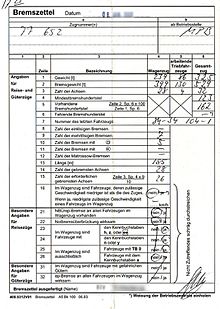Brake slip

The brake slip is a form for informing the driver about the number of axles, train mass and braking conditions of the train.
The braking power of the train, the so-called brake hundredth , is calculated from the braked weight of the train and the train mass (both specified in tons ) . The calculated braking percentages are compared with the minimum braking percentages required for the respective route. Each route is assigned certain minimum braking hundredths, which result from the topography of the route. The steeper sections z. B. the route, the more braking power and thus braking hundredths the train must have in order to come to a safe stop even on the steepest downhill gradients. The minimum braking hundredths refer to 100 t towing weight.
If a train has fewer braking hundredths than necessary, the train may either not travel the route at all or only travel at a reduced maximum speed. For this purpose, the driver receives a so-called schedule message before starting the journey after consulting the operations center , in which the reduced speed or the diverted route is prescribed or communicated to him.
In addition, the brake slip contains further information for the driver, such as the type of brakes ( single release , multiple release , disc brakes , brakes with composite brake blocks (with high, medium or low coefficient of friction)) and their number as well as information about emergency brake override (NBÜ) and electropneumatic brakes (ep). Also included is information on whether the train contains vehicles with dangerous goods and (to identify any train separation) the number of the last vehicle. Furthermore, he can see from the brake slip whether he needs a train driver to handle the train.
Safe driving of the train is therefore not possible without the information on the brake slip. It is therefore imperative to draw up a brake slip before starting the journey, unless the car composition, such as B. the ICE , does not change. In this case, a prescribed brake slip (so-called "permanent brake slip") is available in the driver's cab or entered in the train computer. A brake slip then only has to be created in exceptional cases.